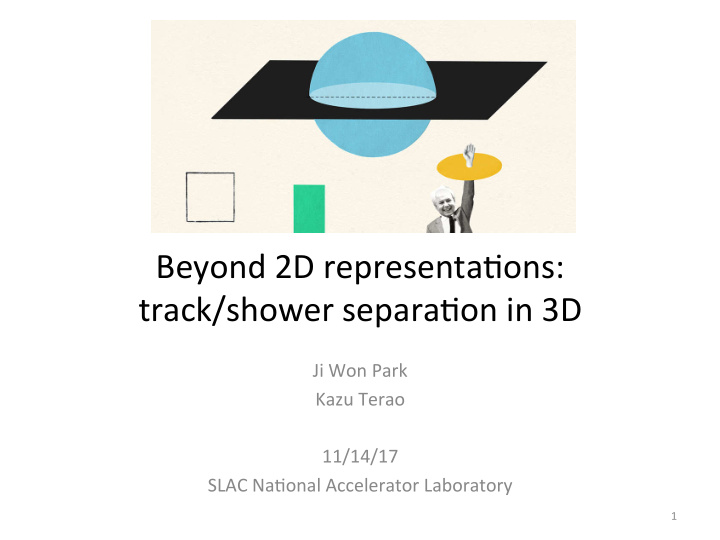



Beyond 2D representa/ons: track/shower separa/on in 3D Ji Won Park Kazu Terao 11/14/17 SLAC Na/onal Accelerator Laboratory 1
INTRODUCTION 2
Mo/va/ons and goals Long-term mission: build a full 3D reconstruc/on chain for LArTPC data using deep learning. Why in 3D? • Less op/cal illusion in interpre/ng 3D data. • PID in 2D and track/shower separa/on in 2D have been done for MicroBooNE data. PaSern recogni/on in 3D is a natural extension from 2D. Goal for the next ~18 minutes: report the results of training a seman/c segmenta/on network to perform track/shower separa/on on 3D simula/on data, as a working test case for paSern recogni/on in 3D. 3
Image classifica3on task in 2D Five-par/cle PID has been done: given a 2D image of a single par/cle, label it as a gamma ray, electron, muon, pion, or proton. pion muon gave a happy score distribu3on. * Muon classifica/on score ~ high likely the algorithm thinks an image is a muon. Assigned high scores for muons vs. low scores for pions à confidence in predic/on J From the MicroBooNE CNN paper (2016) 4
5-par/cle PID in 3D is a natural extension (achieved similar results as 2D) pion muon Voxel = the 3D equivalent of pixel 5
METHODS 6
Our study: shower/track separa3on . (Now 3 classes for track, shower, background instead of 5 par/cle classes) It has been done pixel-level in 2D using seman/c segmenta/on. Truth label Predic/on Yellow: track, Cyan: shower From MicroBooNE DNN paper under review 7
Our study: shower/track separa3on . (Now 3 classes for track, shower, background instead of 5 par/cle classes) It has been done pixel-level in 2D using seman/c segmenta/on. Truth label Predic/on Can reuse the network to do shower/track separa/on in 3D. This study allows us to explore how the technique scales to 3D. Yellow: track, Cyan: shower From MicroBooNE DNN paper under review 8
The seman/c segmenta/on network (SSNet) Two components of SSNet 1. Downsampling path 2. Upsampling path Output Image Down-sampling Up-sampling Input Image Feature tensor Intermediate, low-resolu/on feature map Thank you Kazu for the diagram J 9
Role: classifica3on “WriKen texts” A series of convolu/ons and input image downsampling which reduce the input image down to the lowest-resolu/on feature map. Each downsampling step increases field 1. Downsampling path of view of the feature map and allows it to understand the rela/onship between neighboring pixels. Down-sampling “WriKen texts” feature map Feature tensor “Human face” feature map “Human face” input image Thank you again Kazu for the diagram J 10
Role: pixel-wise labeling 2. Upsampling path ~ reverse version of downsampling path. Up-sampling A series of convolu/ons-transpose, convolu/ons, and upsampling which Feature retrieve the original resolu/on of tensor the image, with each pixel labeled as one of the classes. Segmented output image Each pixel is either “human” or “background” 11
The type of SSNet we used: U-ResNet 1. Downsampling path 2. Upsampling path Feature tensor 12 From MicroBooNE DNN paper under review
The type of SSNet we used: U-ResNet = U-Net + ResNet Within the U-Net architecture, use ResNet modules. In U-ResNet, the convolu/ons are embedded within ResNet modules. One ResNet module: 13 From MicroBooNE DNN paper under review
The type of SSNet we used: U-ResNet = U-Net + ResNet Concatena/ons: a feature of U-Net. We stack the feature maps at each downsampling stage with same-size feature maps at the upsampling stage. ~ “shortcut” opera/ons to strengthen correla/on between the low-level details and high-level contextual informa/on. 14 From MicroBooNE DNN paper under review
Genera/ng images for our training set 3D (voxelized) • Input image: each voxel contains charge info. Each event (image) generated • from truth energy deposi/on from LArSoi. With: – Randomized par/cle mul/plicity 1~4 from a unique vertex per event, where the 1~4 par/cles Proton 300MeV are chosen randomly from 5 par/cle classes. Pion 220MeV – Momentum varying from Electron 240MeV 100MeV to 1GeV in isotropic direc/on. Proton 360MeV – 128 x 128 x 128 voxels à 1cm^3 per voxel (for quick first trial) 15
Label image: each voxel is 0 (background), 1 (shower), or 2 (track). Supervised learning: each training example is an ordered pair of input image and true output image (label). Yellow: track, Cyan: shower 16
Defining the op/miza/on objec/ve (loss func/on) Must weight the soWmax cross entropy. Typically, an image has 99.99% background (zero-value) voxels. Even among non-zero voxels, can have uneven number of track voxels vs. shower voxels. So upweight the “rarer” classes in the image, e.g. if the truth label has ra/o of BG: track: shower = 99: 0.7: 0.3, incen/vize the algorithm to do focus on shower most and BG least by using inverses as weights, 1/99: 1/0.7: 1/0.3. Similarly, monitor algorithm’s performance by evalua/ng accuracy only for non-zero pixels 17
Training Op/mizer: Adam Choose batch size to be 8 images • batch size ~ size of ensemble, so bigger the beSer BUT limited by GPU memory • one itera/on consumed 8 images 18
RESULTS 19
Non-zero pixel accuracy curve Itera/ons Non-zero pixel accuracy = correctly predicted nonzero pixels / total nonzero pixels Each itera/on consumed 8 images. Light orange: raw plot Dark orange: smoothed plot 20
Loss curve Itera/ons Each itera/on consumed 8 images. Light orange: raw plot Dark orange: smoothed plot 21
Truth label Predic3on 22
Truth label Predic3on 23
Truth label Predic3on 24
Summary and future work We have trained U-Resnet to perform shower/track separa/on on 3D simula/on data and report a training accuracy of ~96%. To do: • Explore smaller voxel sizes for higher precision • Vertex finding (adding 1 more class to the classifica/on task) • Par/cle clustering (instead of pixel-level, instance-aware classifica/on) 25
BACKUP SLIDES 26
Overall accuracy curve Itera/ons 27
Why ResNet? This paper demonstrates why ResNet is superior to vgg, etc. in seman/c segmenta/on. 28
Recommend
More recommend